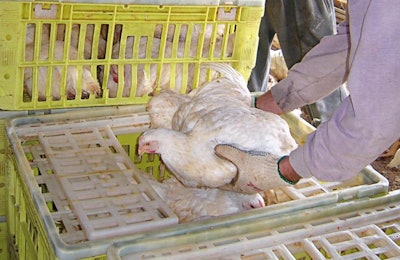
Given the high value of chicken breast meat in many markets, poultry processors need to ensure that any factors that may reduce product quality are thoroughly addressed.
Issues affecting breast meat quality can arise pre-slaughter and during processing, and there are several key areas that need to be properly functioning if losses are to be minimized.
Broiler harvesting, caging
Best practice for capturing birds is to hold them by the body. If birds are caught by the legs, their natural reaction is intense wing flapping, and this puts pressure on the pectoral muscles. Too much pressure and the fragile thorax bones will snap and capillary vessels break, leading to bleeding and breast meat quality issues.
Care must also be taken during caging if damage to the breast, thighs and wings is to be prevented. It is worth remembering that damaged cages can harm birds. Where cage floors are broken, then the breast is particularly vulnerable, as it will be the breast that is pressed against the cage floor and at risk of bruising and bleeding.
Transport to the processing plant
The quality of the journey from the poultry farm to the processing plant can also influence the quality of breast meat harvested from broilers, particularly where there are poor road surfaces and careless drivers.
Poorly maintained roads, and drivers failing to drive with care, will result in birds being jolted, and possibly harmed.
Conditions at the processing plant
Extreme temperatures during transport and while waiting at the plant pre-slaughter can result in dehydration and other metabolic conditions, affecting the health and survival rate of birds, and also meat quality.
Pale, soft, exudative syndrome
Temperature increases in the broilers’ surroundings have been linked to the occurrence of pale, soft exudative (PSE) syndrome.
When temperatures are too high, broilers become stressed and there will be a buildup of lactic acid in muscles due to energy consumption. As a result of this lactic acid increase, muscle pH levels will drop, very quickly becoming more acidic, and this can lead to denaturation of the live muscle protein.
This muscle deterioration becomes evident once the bird has been processed. Meat is paler in comparison to meat from birds that have received careful ante-mortem treatment, is smoother and loses its ability to spring back when pressed. The muscle loses its capacity to hold water, increasing losses during processing and chilling.
Dark, firm and dry
Dark, firm and dry (DFD) meat is also due to ante-mortem stress, primarily resulting from an overly long feed withdrawal, poor management during transport and low environmental temperatures.
A consequent delay in the onset of rigor mortis can result in the pH level remaining elevated, above 6.2, and meat is characterized by being dark in color in comparison to normal meat. There is also an appearance of dryness and the muscle’s water content is tightly bound to its protein, preventing it from rising to the surface.
DFD meat has a firm texture, due to its fibers being stiff. It cannot be used in added-value products, and its shelf life is short.
Woody breast
This condition is attributed to raising heavier birds in shorter periods. The breast meat is characterized by being tougher than normal, necessitating more chewing at consumption. The problem has resulted in many producers removing it from the processing line and sending it for use in other products such as sausages.

Woody breast is typified by breast fillets that are hard and chewy. | Courtesy University of Arkansas
Bleeding and scalding
If bleed time is too short, residual blood will be left in the broiler carcass. Approximately 3 percent of live body weight needs to be lost during bleed and prior to entering the scalder, as remaining blood can increase pH levels, making the meat appear dull and resulting in a darkening of its natural color.
Scalding also needs to be well managed. Overscalding can affect the larger pectoral muscle, leading to the denaturation of the meat protein.

Overscalding can also lead to breast meat quality problems. | Eduardo Cervantes López
Nutritional approaches to broiler breast meat quality

















